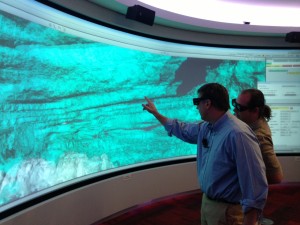John Crock presented “3D Modeling and visualization of Amerindian Cave Sites and Rock Art in the Caribbean” (with Wetherbee Dorshow, Ph.D.; Earth Analytic, Inc.) at the new Center for Advanced Visualization and Experiential Analysis (CAVEA) at Metropolitan State University of Denver on 11/6/2013. This technology allows a 3D rendering of caves containing rock art from Anguilla, which have made visible petroglyphs invisible to the naked eye. He also presented at University Colorado Colorado Springs on 11/5. The abstract of the talk at CAVEA follows:
Recent use of a Faro laser scanner to map caves and other sites with prehistoric rock art in Anguilla, British West Indies, demonstrates the utility of terrestrial LiDAR technology to help document, preserve and interpret significant archaeological sites that are often inaccessible to the general public. The results from Fountain Cavern, a ceremonial cave site with human-carved stalagmites and other rock art, and Big Spring, a limestone sink hole site with scores of petroglyphs, illustrate the utility of laser scanning in heritage management, specifically as a tool to enable highly fragile resources to be protected and preserved while also being made accessible within a digital 3D environment. The use of laser scanning to enhance the identification of rock art is also explored using the Anguilla to emphasize the interpretive value of three-dimensional representations of the artwork.



Recent Comments